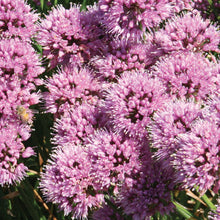Allium ‘Windy City’ is a clump forming late summer bloomer that brings upright structure, vibrant color, and lasting ecological benefits to the garden. Developed for its durability and ornamental beauty, this compact allium features tight globe shaped clusters of rose purple flowers that attract a wide array of pollinators.
Height & Spread: 15 - 20 in x 10 - 14 in
Bloom Time: Summer (July through August)
Light Requirements: Full sun, tolerates light shade
Soil Preference: Well drained soil; performs well in sandy, loamy, or clay soils
Watering Needs: Low to moderate; once established, it is drought-tolerant
Deer Resistance: Highly resistant to deer and rabbits due to pungent foliage and bulbs
NATIVE STATUS
Cultivated hybrid, not naturally occurring in the wild. Its parentage includes non native alliums, so it is not a North American native. However, it supports many native pollinators and behaves well in managed landscapes, making it an ecologically supportive non invasive choice.
WILDLIFE & INSECTS
Butterflies
- Attracts numerous butterfly species, including Swallowtails, Painted Ladies, and Skippers. Because it blooms in late summer, it serves as a critical nectar source when many other flowers have faded.
Bees
- Especially attractive to honeybees, native solitary bees, and bumblebees, which forage heavily on its flowers. The structure of the flower heads provides easy access to nectar and pollen, supporting pollinator health and biodiversity.
Beneficial Insects
- Hoverflies, parasitic wasps, and lacewings are drawn to the blooms, helping control pest populations naturally in the surrounding garden.
Birds
- Though not a major bird plant during bloom, the dried seed heads can offer food for small songbirds like finches and add winter interest to the landscape if left standing.
SPACING & LANDSCAPE USE
Spacing Recommendations
-
Plant 12 - 14 inches apart to allow for air circulation and full development of its rounded form. This spacing also enables easier movement for pollinators and reduces disease risk in humid climates.
Landscape Placement
- Use in the front or mid-border, mass plantings, or pollinator gardens. Its structured form and consistent bloom make it a reliable performer in formal beds, urban landscapes, or xeriscapes.
COMPANION PLANTS
-
Echinacea pallida (Pale Purple Coneflower) - Offers a complementary bloom time and height while drawing in bees and butterflies.
-
Salvia nemorosa (Wood Sage) - Drought tolerant and bee friendly with earlier blooms that transition into Allium’s season.
-
Agastache (Blue Fortune) - Long blooming and attractive to hummingbirds and butterflies, offering a vertical accent.
-
Nepeta racemosa (Catmint) - A fragrant sprawling perennial that contrasts well with the upright form of Allium.
-
Coreopsis verticillata (Threadleaf Coreopsis) - Bright airy texture with cheerful yellow flowers for high contrast combinations.
-
Schizachyrium scoparium (Little Bluestem) - Adds motion and fall color while supporting native insects and birds.
-
Lavandula x intermedia (Lavender) - Highly aromatic, pollinator friendly, and thrives in the same dry sunny conditions.



